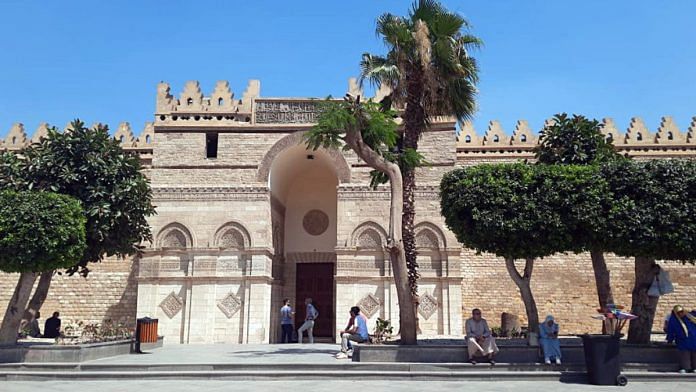New Delhi: Right after the US, Prime Minister Narendra Modi has set off for another state visit, to Egypt. Amid a number of important engagements to strengthen diplomatic relations and bilateral ties between both countries, the PM is set to visit the iconic Al-Hakim Mosque in Cairo on 25 June — an 11th century mosque that was repaired with help from the Dawoodi Bohra community, a significantly loyal vote base of the BJP in India.
One of the holiest sites for Egyptian Muslims, the mosque, which is situated on the eastern side of al-Mu’izz street in the centre of Cairo, underwent extensive renovation over several years. According to local reports, the Dawoodi Bohras Ismaili Shiite sect donated approximately 85 million in local currency for the mosque which is an important cultural site for the community in Cairo.
In February this year, it was reopened to the public. Media reports cited Presidential spokesperson Bassam Rady as lauding Mufaddal Saifuddin, the Sultan of the Indian Bohra community and the 53rd al-Dai al-Mutlaq, their spiritual leader, for significant contributions to the renovation and restoration of several shrines and historic mosques in Egypt.
PM Modi has had a long-standing association with the Bohra community so his visit to the mosque holds significance for the latter. On the PM’s visit, a Twitter page of the community talked about the significance of the mosque.
The Hon’ble Prime Minister of India, Shri @narendramodi ji on his two-day visit to Egypt is expected to visit Al-Jami al-Anwar (Masjid al-Hakim) in Cairo.
Read about the close connection the Dawoodi Bohras have with Masjid al-Hakim here. @PMOIndia https://t.co/rKxbvdVQxg— The Dawoodi Bohras (@Dawoodi_Bohras) June 21, 2023
Also read: US, India terminate six disputes at the WTO after Modi’s visit to the US
Significance of the mosque
The construction of the mosque, began in 879 AD by Ahmed Ibn Tulun, the founder of Egypt’s Tulunid Empire, was completed in 1013. It is the fourth-oldest mosque in Egypt and the second-largest in Cairo. With the passage of time, the mosque fell into a state of neglect and its role as a masjid all but ended, the official page on the mosque noted.
With the entry of Europeans in Egypt, particularly in the 19th and early 20th centuries, its precincts were transformed into a fort, stables, a museum, a warehouse, and a school. In 1979, it was added to the UNESCO World Heritage List as a part of historic Cairo.
Dawoodi Bohras
The Bohras are a sect of Shi’a Isma’ilis, spread across both India and Pakistan, partly Hindu in origin and partly Yemenite, whose roots trace back to Egypt.
They get their name from the Gujarati term vahaurau, which means “to trade”. While the group can be found in Maharashtra, and Madhya Pradesh, Gujarat’s Surat is considered their home base. The Bohra population in India is estimated to be over 500,000, with another 10 lakh individuals spread across the globe, according to media reports.
The Dawoodi Bohras are guided by their leader, known as the al-Dai al-Mutlaq (unrestricted missionary), who first operated from Yemen and then, for the last 450 years, from India.
According to thedawoodibohras.com, which claims to be the official website of the community, they got the name after emperor Akbar acknowledged the authority of Dai Syedna Dawood bin Qutubshah as the 27th dai. In India, a sizable community of followers had existed since the 5th century.
The Dawoodi Bohras adhere to the Fatimi Ismaili Tayyibi school of thought – tracing their heritage to the Fatimi Imams, direct descendants of the Prophet, in Egypt.
While the Bohras are famed for their progressive perspective, one of their worst kept secrets is the practice of female genital mutilation. The UN has deemed it a human rights violation yet it is practised in India, show media reports.
PM Modi & Dawoodi Bohras
The spiritual guide of the community, Syedna Mufaddal Saifuddin, mostly resides in India. The group is among the primary supporters of the BJP among Gujarati Muslims.
Syedna Mufaddal Saiffudin has often lauded Prime Minister Narendra Modi’s ‘Make in India’ initiative and other schemes.
Following Gujarat’s 2002 riots which disillusioned the Muslims, the state government nurtured ties with the community. The previous Syedna, Mohammed Burhanuddin, openly backed the then Chief Minister, Modi.
When Modi started the Sadbhavna Mission to promote communal unity in Gujarat in 2011, it was the Dawoodi Bohras who showed up in force.
Earlier this year, while inaugurating the new campus of Aljamea-tus-Saifiyah (Saifee Academy), an educational institute of the community at Marol in Mumbai, PM Modi claimed he was attending the event as a family member who has been associated with the community for four generations and called them the ‘brand ambassadors of shining India’.
The Dawoodi Bohras have about 5,000 families distributed across the US, according to the webpage of the community in the US.
Ahead of Modi’s visit, they tweeted, “The community is honoured to be part of this historic occasion, reflecting on their commitment to fostering harmony between their beloved home, the United States, and their cherished Indian roots.”
(This is an updated version of the article.)
(Edited by Smriti Sinha)
Also read: India-Bangladesh rail link via Agartala to be operational by 2023 end, ‘help boost bilateral ties’



